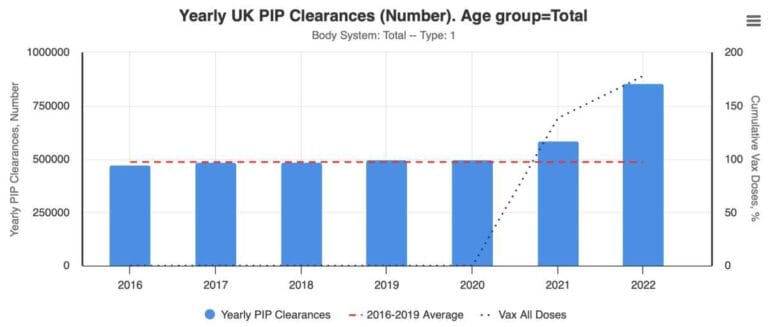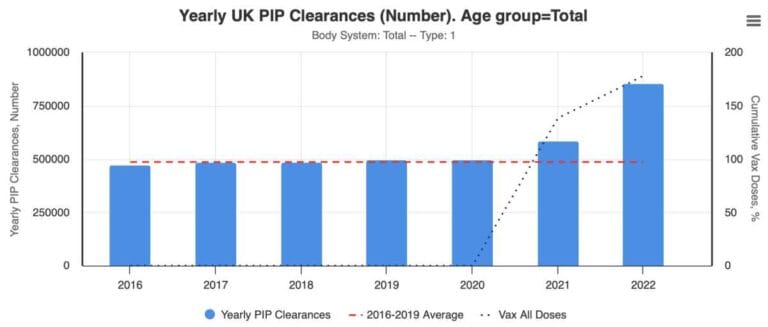Table of Contents
Dr. Guy David Hatchard
Guy is an international advocate of food safety and natural medicine. He received his undergraduate degree in Logic and Theoretical Physics from the University of Sussex and his Ph.D. in Psychology from Maharishi University of Management, Fairfield Iowa. He was formerly a senior manager at Genetic ID, a global food safety testing and certification laboratory. His published work uses the statistical methods of the physical sciences to analyse social data.
This release reports increased trends of cancer incidence that suddenly accelerated after the vaccine rollout began. First, we consider what the media are currently reporting about rising cancer incidence and then what they could have investigated but haven’t.
A study published in BMJ Oncology this month entitled “Global trends in incidence, death, burden and risk factors of early-onset cancer from 1990 to 2019” has reported a 79.1% rise in cancer incidence among people under 50 years of age during the last thirty years. This averages to a 2.6% annual rise. Over 350 news outlets around the world have published articles reporting the results.
Developed nations, including North America, Western Europe, and Oceania (that’s us), are disproportionately affected. The authors suggest that:
“Dietary risk factors (diet high in red meat, low in fruits, high in sodium and low in milk, etc), alcohol consumption and tobacco use are the main risk factors underlying early-onset cancers.”
In addition to these factors, the authors also explain that changes in lifestyle and environment since the turn of the 20th century, resulting in increased rates of obesity, physical inactivity, westernised processed diets, and environmental pollution, may have affected the incidence of early-onset cancer.
These are, of course, alarming figures. Concern has been widely registered around the world. More than 1 million under 50s now die annually from cancer worldwide. The identification of possible causes in the study is helpful. It points to factors that are particularly prevalent in richer nations.
What Has Been Happening Since 2019?
You might have noticed that the study covers data up to the end of 2019, and you are perhaps wondering what is happening now. If you have been reading our reports, you probably know that up-to-date data on specific disease categories is hard to come by and might just be subject to some form of suppression. You have to dig around to get a hold of the current situation.
Phinance Technologies, a company specialising in independent data mining and consultation, has published an analysis of UK disability claims over the last seven years (https://phinancetechnologies.com/HumanityProjects/PIP Analysis-Systems.htm). The total number of new claims for Personal Independence Payments (PIPs) for all ages and all causes made by people claiming disability is graphed as follows:

The 2022 rate of new claims was 71% higher than the average
2016-2019 rate and mirrors the Covid vaccine rollout.
Phinance Technologies also reports separate data for payments made to
those suffering from disability due to cancer incidence. These payments
increased by 35% in 2022 compared to the long-term average. An increase
of 12,271 cases.

It is interesting that a 79% increase in early onset cancers over a thirty-year
period has elicited global concern and publicity, whereas a 35% rise in
cancer incidence over one year after the vaccine rollout began, a rate 13
times higher, has been ignored by mainstream media. How strange is that?
Just imagine if these figures are being replicated around the world. That
would amount to an additional 1 million cancer cases, being quietly swept
under the rug. One million people are unaware of a possible deadly cause of
their disease—Covid vaccination—being administered by the same health
professionals who say they are dedicated to preserving public health.
The figures are even more concerning if you consider the increase in the total
number of people applying for disability payments in the UK because they
are unable to work due to various conditions—372,000. If this is being
repeated worldwide, in 2022 there will have been 31 million new cases of
disability. A figure that is similarly being swept under the rug by medical
authorities and governments.
Here in New Zealand, we have few reasons to doubt the validity of these
figures. The Household Labour Force Survey reports that there are 6600
working age people (15-64) who dropped out of the workforce through
disability in the year since June 2021 when vaccination of this age group
began. Leaked hospital data from the Wellington Region revealed a rising
incidence of cancers. We know that our health service is overwhelmed, but
we are still being offered puerile excuses by our politicians, medical
authorities, and mainstream media.
We are daily being treated to heart-wrenching personal stories in the press
about working age and student people who are falling ill or even dying
unexpectedly. In a few cases, we are being told that we will have to wait for a
coroner’s report to know why, but as long as public health data remains
hidden, parents, friends and colleagues may never know why.
No doubt there are multiple causes for serious illness and excess deaths
including pre-existing conditions, delays in treatment due to pandemic
lockdowns, long Covid and covid infection, poverty, poor lifestyles, etc. But
it seems from whatever data we do have that the most significant cause of
appalling hospital statistics is likely to be quite different from the tired
excuses currently being rolled out for public consumption. Watch this video
to get an update on excess deaths by country which remain high in nations
with high Covid vaccination rates, but are below the long-term average in
countries with low vaccination rates.
As long as complete public health data broken down by vaccination status,
age, and condition is being kept well hidden and withheld from independent
researchers no one will know what exactly is going on. Overseas data is now
catching up with us. New Zealand can’t keep its head in the sand any longer.
This needs to be a topic in election debates and at public meetings.
Candidates are showing their disdain for the New Zealand public by refusing to
address the growing evidence of COVID-19 vaccine harms on a scale that dwarfs previous risks to public health. Time to wake up, get up to date and show some respect.
Many people write to me, some of them performing important roles in
society, expressing concern, regretting that there are few forums where they
can make their concerns known. The cancellation of these voices, as well as
continuing government funding of unqualified fact checkers and so-called
disinformation experts in the face of mounting scientific evidence of Covid
vaccine harm is becoming a serious matter.
This week, I read an account of a former pillar of the UK media establishment
and editor of the Independent on Sunday and the New Statesman, Peter
Wilby. He spent years cancelling and denigrating victims of child abuse, but
has recently been exposed as a prolific collector of sickening explicit child
sex abuse images.
Wilby used his influence to craft a media environment which was hostile to
whistleblowers and journalists working to expose child sex abuse,
characterising the victims as easily manipulated by overzealous reporters
engaged in a witch-hunt. Wilby used his power in the media to call for
‘nuance’ and a more relaxed and understanding stance towards abusers.
We can’t help but feel threatened by how much power our media has to
shape public narratives that don’t have a basis in reality. They have failed the
New Zealand public. If we don’t learn from the pandemic, we have failed as a society to protect ourselves from abusers and misinformation. Our politicians need to take note, political ideology and belief devoid of relevant information do not amount to a public health policy with any chance of success.









